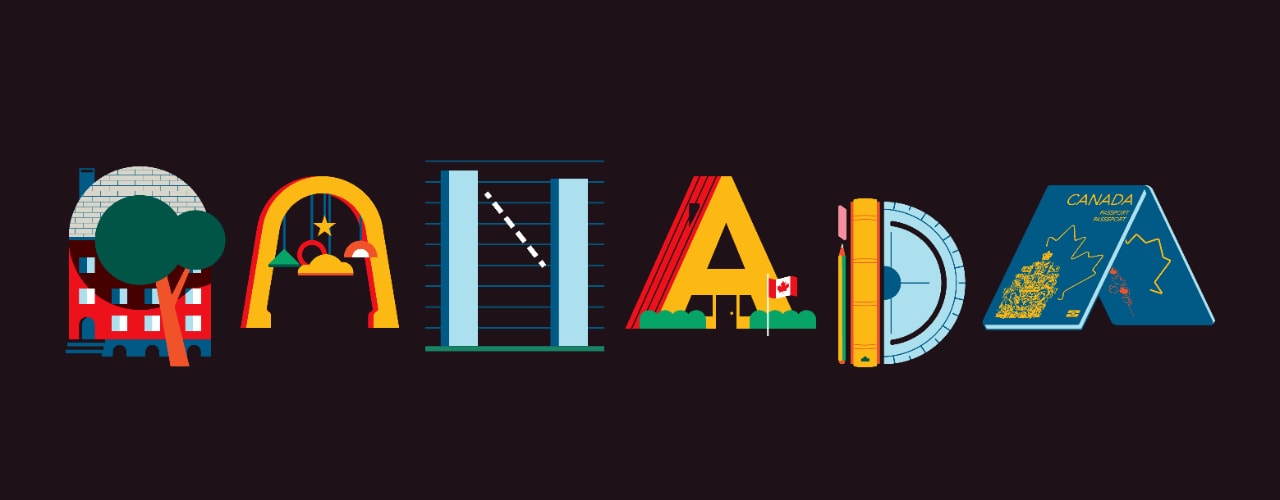Key takeaways:
Moving to a new country is a big job. Between getting a work permit or visa and finding housing and a job, there’s a lot to do.
If you’re hoping to become a permanent resident, or are an international student or foreign worker, you can get a head start by opening an international bank account before you leave your home country.
Read on to learn all about choosing the best bank account as a newcomer to Canada and how to get the process started.
It might seem unnecessary to open a Canadian bank account before you move to Canada rather than once you’re here, but there are some very good reasons to do so.
1. First step towards your new life in Canada
Opening a Canadian bank account is one of the first steps toward setting down roots in Canada. As a part of your application, the bank will check your identification and other paperwork. This helps let other institutions, like telephone companies or rental agencies, know you are who you say you are.
Plus, a Canadian bank account will let you pay for things ahead of time without having to worry about wire transfers, holds on your funds or foreign currency exchange rates. Also, when you rent an apartment, pay bills or get a Canadian phone line, you'll be able to pay in Canadian currency out of your new bank account.

2. Shows that you can support yourself
If you’re coming into Canada as a skilled worker, but don’t have a job lined up with a Canadian employer, you’ll have to prove to immigration that you have enough money to support yourself and your family once you arrive in Canada. Canadian immigration officers recognize a Canadian bank statement as proof of funds, making the process of landing in Canada a bit smoother.
3. Use it to send money to Canada
Once you have a Canadian bank account, you can wire transfer yourself up to $50,000 CAD before you move. There are many reasons to transfer your money rather than travelling with it.
First of all, having funds in a bank is far safer than carrying cash. If you travel with cash, it could be stolen. Also, you have to declare amounts of more than $10,000 to the Canadian Border Security Agency when you arrive, which could cause stress and delay your travels.
The Canadian banking system is very reliable and secure — the Canadian Deposit Insurance Corporation (CDIC) insures all deposits up to $100,0001 — so you can count on your money being in your account when you arrive.
4. Potentially start building a Canadian credit score

In Canada, credit is a common part of daily life, and your credit score is an important number. Lenders like banks or credit card companies check your credit score to decide whether to lend to you. The higher your credit score, the more trustworthy you're deemed at paying back debts.
For example, a lender will check your credit score before they approve you for a loan, mortgage or credit card. It can even affect whether you get a job or an apartment.
If you're a newcomer, you arrive without any credit history and have to start from scratch. Canada's two main credit bureaus track your debts to create your credit report, which your credit score is based on.
Lots of things help you build a credit score, including:
- Watching how much debt you have
- Making bill payments on time
- Establishing financial accounts
While having a bank account may not necessarily build your credit score, the other types of accounts it helps you set up — like with a telephone or utility company — do. Being able to show a Canadian banking history will also help while applying for a credit card or other type of loan.
5. It’s easy!
Opening a Canadian bank account is easy. For example, it only takes 10 minutes to apply for the Scotiabank International Account and you can do it online. Once your account is activated, money you wire transfer will be deposited within 10 days. Then, you can start making arrangements while you're still in your home country.
Once you arrive in Canada, you’ll need to open a chequing account for your daily banking like Automatic Banking Machine (ABM) withdrawals and bill payments. If you have a Scotiabank International Account, setting up a Scotia chequing account is straightforward. You'll even be able to transfer all or part of the funds from your international account into your new chequing account.
Once you decide to open a Canadian bank account, your next step is to choose the right one for your needs. You’ll want to compare the financial institutions and the accounts they offer; for example, you should look at:
- Monthly account fees
- Interest rates
- Account options and features
- How many debit transactions and Interac e-Transfer§ transactions are included each month
You should also research the bank’s customer service, security, number of branches and ABMs, and whether they have online banking and an app for mobile banking. These features will save you time and allow you to bank from anywhere that has an internet connection.
You'll also need to think about your banking needs as a newcomer to Canada. Most people start with a chequing account for everyday spending and a savings account to keep money for emergencies or short-term goals.
Having a credit card is also useful, because using it wisely can help build your credit score. Plus, some credit cards come with valuable perks, such as earning rewards points or cash back.
You should also check to see if the financial institution you’re considering offers investment accounts like Guaranteed Investment Certificates, Registered Retirement Savings Plans or Tax Free Savings Accounts.
Some banks, like Scotiabank, have made it easy for newcomers by putting together packages tailored to your needs.
The Scotiabank StartRight® Program walks you through the process of setting up your finances, from before you leave your home country to when you're building your new life in Canada.
Let’s walk through all the steps to account opening, including what documentation you’ll need, to begin your Canadian banking relationship with Scotiabank.
Before you arrive in Canada
If you choose to open a Scotiabank International Account from outside the country, you can do so online. The first step is to check your eligibility.
You must:
- Be approved to come to Canada as a permanent resident, international student or foreign worker
- Be at least 13 years old
- Be coming to Canada within 18 months from the date of your application
- Not be coming to Canada on a tourist or visitor visa
If you’re eligible, make sure you have this information handy:
- Passport
- Date of arrival in Canada
- Canadian visa or landing document number
On arrival in Canada
Your first step is to visit a Scotiabank branch and work with a representative to open chequing and savings accounts.
You’ll need these documents:
- Permanent resident card, confirmation of permanent residence, or work permit
- An additional piece of government photo ID, such as your passport or Canadian driver’s licence
With the StartRightTM program, your monthly bank fees are waived for the first year with the Preferred Package1. The bank representative can help you transfer some or all of your money from your international account to your chequing account. Once your chequing account is active, you’ll get a debit card that you can use to make purchases and withdraw money from ABMs.
You'll also have access to unlimited no-fee international money transfers2, making it easy to send money to family or friends back home.
Through the StartRightTM program, you can also apply for a credit card to help start building a Canadian credit history. If you’re a foreign worker, you’ll need to bring a letter from your employer in Canada stating your annual income.
You can continue benefiting from the StartRightTM program even after you’ve lived in Canada for some time up to 3 years in Canada. When you're ready to buy a home, you can consult with Scotiabank's home financing advisors. Scotiabank advisors are there to help you as you build your life in Canada.

There are many benefits to getting a head start on your new life in Canada. Opening bank accounts, getting a credit card and sending money home are all simple when you enrol in the Scotiabank StartRight® Program. Consider starting your journey now, by opening a Scotiabank International Account, so you can hit the ground running.


